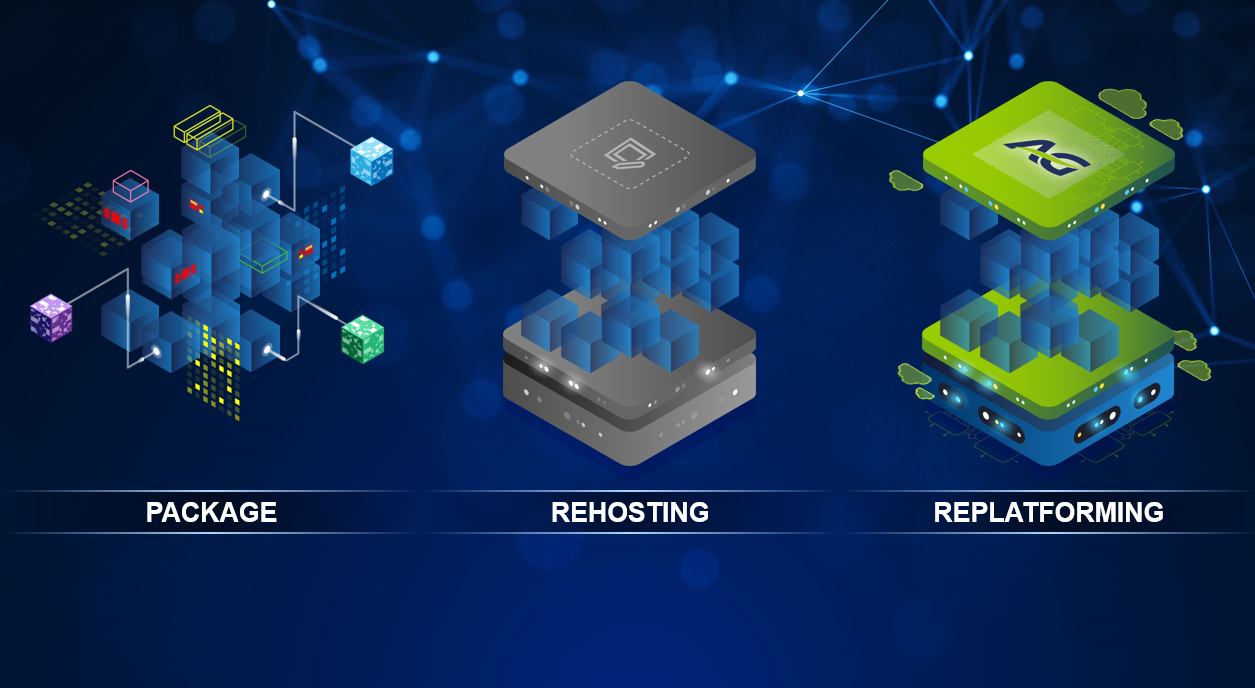
José Fortemps
Chief Technology Officer
Making lemonade: evaluating our options
Our partners' banking applications and our insurance applications were deeply intertwined. Before we could even fathom a replatforming, we started disentangling several applications to gain technological independence and flexibility. However, we faced an unexpected challenge when our banking partner set a 2022 deadline to exit their mainframe, which compelled us to look for alternatives.
- We first considered adopting packaged solutions. However, going the package route would've decreased the number of homemade Cobol assets applications and thus diminished the competitive edge they provide us.
- The second option was rehosting to a mainframe of our own. A safe operation but not future-proof. A mainframe lacks flexibility and openness, limiting its potential exposure to new technologies and innovations, like .NETcore or cloud APIs. We knew they'd become obsolete by 2030.
- We opted for the third option: replatforming our entire infrastructure to distributed Windows SQL servers. There are numerous reasons why. This option enables integration with other partners, services, and technologies and narrows the gap with our recently built cloud-based data platform. These integration capabilities position us to gradually improve our core Cobol applications with new technologies and leverage the scores of unstructured data to provide our clients with personalised digital microservices.

Designing the replatforming: setting the stage
Such a massive and unique endeavour, with only four successful replatforming programs of this magnitude recorded, requires meticulous preparation. The process was three-pronged:
- Our teams first designed the target platform. We envisaged a network of Windows SQL servers equipped with HPE Synergy and HPE Primera storage, creating the full mainframe workload in the AG Insurance data centres. HPE Synergy is a software-defined composable infrastructure to manage and deploy IT resources quickly and for any workload. HPE Primera delivers instant access to data with storage that sets up in minutes, upgrades transparently, and is delivered as a service.
- Simultaneously, we had our code and data patrimony thoroughly analysed to design the first iteration of a conversion engine provided to us by our partner, HP Enterprise. We crafted the engine to convert 300 TB of data and 80 million+ lines of code stored on the old infrastructure and make it compatible with the new platform.
- This ties in with the third concurrent part of the design phase: the testing strategy. This essential phase interplays closely with the previous design phases, dictating the planning and the conversion phases. The entire replatforming program hinged around these testing moments. Each conversion iteration serves to finetune the conversion engine until it operates seamlessly and to ensure that all the data and code, are correctly converted. After six iterations and extensive testing over three years, we felt confident about the conversion engine.
No smooth sailing: managing technological challenges
Despite the meticulous design and planning, we faced numerous technological challenges. Batch testing presented difficulties. AG's applications patrimony heavily relies on the batches, processing 17 million daily transactions. The sheer volume of data makes them prone to many errors.
On top of that, our applications turned out to underperform after the first iteration of the conversion engine. Their response times rose significantly both online and in the batches. It took a Herculean effort by our teams and several conversion iterations to improve the response times.
A third challenge had to do with the readiness of our team. Our infrastructure and development teams had to be able to manage the new platform and develop it from day one. That's why we deployed a change management track, organised training sessions for our team members, and empowered our replatforming champions to guide our colleagues through this transformative period.
Beyond technology: a human journey
After we addressed these and many smaller issues, we executed the cutover in four days. During these nerve-wracking days, we successfully converted and re-platformed all our assets. And despite two hiccups, this process went surprisingly well. We had an immediate 99.75% SLA and have maintained that level of availability to this day.
This success is more than a technological tour de force. It's a testament to our teams' ingenuity, flexibility, and communication skills. Some of our team members had reservations about the feasibility and necessity of this endeavour. We made a concerted effort to discuss and address these worries and get our more hesitant team members aboard the replatforming train.
Our communication strategy wasn't a top-down approach. There was a continuous dialogue, fostering idea exchange across all levels. We also set up a training hub for skill development and identified champions who wholeheartedly embraced and advocated for the replatforming concept. Furthermore, we ensured that our control units and board of directors were kept in the loop of all the milestones, setbacks, and improvements.
This constant communication nurtured widespread support, and company-wide involvement. Every single stakeholder was invested and played a crucial part in this program. We couldn’t have garnered such engagement without communication. But our communicative efforts yielded more than engagement. The ongoing flow of discussions, opinions and ideas led to solutions to our challenges.
We took the same approach when communicating with and mobilising our external partners. A project of this magnitude requires more than the offerings contractually stipulated. Through regular discussions, we emphasised the significance of the end goal, creating a strong sense of urgency and engagement. This motivated them to go above and beyond their SLAs.
Reaping the short-term and long-term benefits

The replatforming is nothing short of a resounding success on different fronts. We created a scalable, open and flexible platform, which positions us to improve our Cobol applications with .NET core and C# assets, and connect with cloud APIs.
Another significant benefit is the path to digitalised microservices. By moving our infrastructure to Windows SQL servers and simultaneously migrating our data infrastructure from the SAS on-premises platform to the Microsoft Synapse Analytics platform, we’ve bridged the technological divide between operational systems and data and analytical systems and data, fulfilling key prerequisites needed to become a data-driven company.
The new technological convergence optimises the delivery of operational data for the business units. Simultaneously, it reduces the data ingestion cost and shortens the market time. The upgrade bolsters our data capacity management and enables us to integrate the operations and analytics data via parametrisation instead of laborious programming.
The replatforming also fundamentally altered the way we work. Consistent cross-departmental collaboration led to a permanent tearing down of silos. These benefits all lead to an uptick in efficiency and cost reduction. Our TCO shrunk by 75%, which we'll invest in digitalisation projects.
We're now primed to provide our clients with personalised and efficient digital services. These benefits are just the tip of the iceberg. We expect more improvements and innovations as we continue to leverage our new platform.
